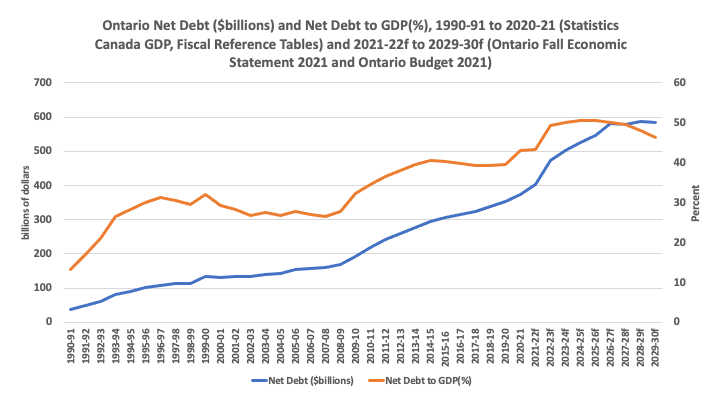‘Debt’ decision looms for Ontario’s government

As Ontario’s spring budget approaches, it will be interesting to see the scope of the forthcoming deficits and net debt in the pandemic’s wake. Ontario’s fiscal watchdog already predicts that Ontario will face smaller budget deficits over the next few years compared to forecasts in recent economic updates because of greater-than-anticipated revenues. If this is indeed the case, it may help the province avoid what could be its third age of debt in the last 30 years.
To start, Ontario’s 2019-20 fiscal year at the pandemic’s dawn saw total provincial government revenues of $156.1 billion and total expenditures of $164.8 billion for a deficit of $8.7 billion. According to the fall 2021 Ontario Economic Outlook and Fiscal Review, in 2020-21 Ontario saw total revenues of $164.9 billion and total expenditures of $181.3 billion for a deficit of $16.4 billion. The outlook for 2021-22 was expected to see total revenues of $168.6 billion and total expenditures of $190.1 billion for an anticipated deficit of $21.5 billion. Going into 2022-23, revenues were forecast to continue rising to $171.5 billion but total expenditures are forecast to rise only slightly to $191.1billion, for a deficit of $19.6 billion.
During the pandemic we saw an increase in expenditures, but in the end provincial revenues did not collapse. The two-year period from 2019-20 to 2021-22 saw total provincial government revenues rise by an estimated 8 per cent while total spending grew by 15.4 per cent. The increase in spending generated a debt surge, which, when placed in historical perspective, parallels previous times of economic challenge.
The chart below plots the absolute value of Ontario’s net debt since 1990-91 with forecasts to 2023-24, and the net debt-to-GDP ratio.

Between 1990-91 and 2020-21, Ontario’s net debt grew from $38.4 billion to $373.6 billion and by 2023-24, in the pandemic’s wake, is expected to reach $503.3 billion. As a share of provincial GDP, net provincial government debt was 13.4 per cent in 1990-91 and grew to 43.1 per cent by 2020-21. According to longer-term fiscal projections in the spring 2021 provincial budget, net debt-to-GDP is expected to plateau by the mid-2020s at about 51 per cent before declining to 46 per cent by 2029-30.
Indeed, there have been three waves of rising debt-to-GDP burden—the recession era of the early 1990s, the period following the 2007-08 financial crisis and Great Recession, and now the COVID pandemic. While the first two surges were followed by net debt-to-GDP plateaus marking periods of temporary sustainability, the overall trend is a rising net debt-to-GDP ratio over a 30-year period. Ontario essentially has a long-term fiscal sustainability problem that’s punctuated by short-term periods of seeming sustainability. Once the net debt-to-GDP ratio stabilizes, any sense of urgency fades and a “business as usual” approach to public finances resumes.
Ontario seems poised to enter yet another period of short-term fiscal sustainability marked by a flat net debt-to-GDP ratio following a debt-to-GDP surge. If revenues indeed turn out to be greater than anticipated in coming years, the provincial government will once again be tempted to postpone any concerted efforts to balance the budget, pay down debt and ensure long-term fiscal sustainability.
Given Ontario’s fiscal history, it’s hard not feel a sense of déjà vu given this has happened before and may now be about to happen again. Nonetheless, it would appear there will likely be yet another a window of opportunity over the remainder of the 2020s for the provincial government to help restore its longer-term fiscal sustainability.
Author:
Subscribe to the Fraser Institute
Get the latest news from the Fraser Institute on the latest research studies, news and events.

